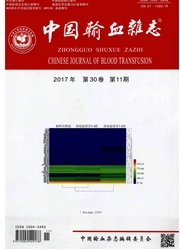

 中文摘要:
中文摘要:
目的探讨血液保存时间和过滤、离心等前处理操作对红细胞携氧功能及能量代谢的影响。方法取不同保存期血样用血氧分析仪检测携氧能力并同时测定葡萄糖、Na^+、K^+及乳酸脱氢酶等能量代谢相关指标。结果全血和悬浮红细胞的有效携氧量随保存时间延长逐渐减少,在第1周分别下降了27.5%和19.2%。到保存末期,全血的有效携氧量仅为“新鲜血”的39%,悬浮红细胞也只有采血当天的51%。P50值在保存期总体呈减小趋势,在开始2周减少较快,随后变化不明显。葡萄糖逐渐消耗;乳酸脱氢酶随时间逐渐增加,全血到保存末期为采血时的近3倍。Na^+浓度呈进行性下降,K^+浓度逐渐增加,到保存末期悬浮红细胞K^+增加了3倍。结论血液保存时间和前处理操作等对血红细胞携氧能力及能量代谢有重要影响,过滤、离心等操作会对红细胞造成一次性损伤。
 英文摘要:
英文摘要:
Objective To evaluate the impact of storage time and pre-treatment process on the oxygen-carrying function and energy metabolism of red blood cells. Methods Oxygen-carrying capacity was measured by HEMOX-ANALYZER, and the concentrations of glucose, Na^+, K^+ and lactate dehydrogenase were also detected at different storage time. Results The effective oxygen-carrylng volume of whole blood and suspended RBC decreased by 27.5% and 19.2%, respectively after 1 week, and at the end of preservation, the volume decreased to 39% and 51%, respectively. P50 values decreased during the preservation period, which was redueed sharply at the first two weeks, but then showed no significant change. Glucose level gradually reduced, and lactate dehydrogenase increased rapidly with storage time, and tripled at the end of storage. Na^+ concentration declined, and K^+ concentration gradually increased. K^+ of suspension RBC also tripled at the end of storage. Conclusion Blood storage time and pre-treatment process have an important impact on RBC oxygencarrying function and energy metabolism. Such treatments as filtration, centrifugation and others could result in a one-time injury to RBC.
 同期刊论文项目
同期刊论文项目
 同项目期刊论文
同项目期刊论文
 期刊信息
期刊信息
